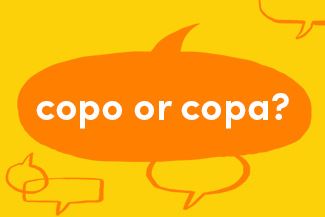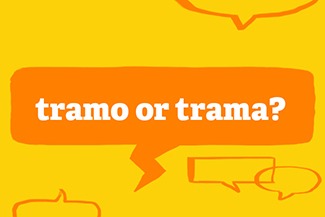This week we put another pair of Spanish nouns under the microscope to uncover their different usage despite their similarity in form. This week’s masculine and feminine pair are copo and copa.
Let’s start with the less common copo (masculine). You can listen to its pronunciation here:
Commonly heard in the expression copo de nieve (snowflake), un copo is a flake, or something resembling this:
Desapareció como un copo de nieve al sol.
It disappeared like a snowflake in the sun.
Por la noche, los primeros copos cayeron sobre la Sierra Nevada.
The first (snow)flakes fell on the Sierra Nevada in the night.
copos de jabón
soap flakes
los copos de patata deshidratados
dried potato flakes
Now let’s move on to the more common copa (feminine), whose pronunciation can be heard here:
Like un vaso, una copa means a glass, but whereas un vaso is usually a simple glass, una copa has a stem:
Regresó con una bandeja de plata y dos copas.
She returned with a silver tray and two glasses.
mesas cubiertas de copas vacías
tables covered with empty glasses
Una copa is also whatever liquid is in the glass:
Bebió su copa de un sorbo.
He downed his glass in one gulp.
Ana había bebido dos copas sin respirar.
Ana had knocked back two glasses without stopping for breath.
You might want to go for una copa (a drink) with friends:
Vamos a tomar una copa juntos.
Let’s have a drink together.
Te invito a tomar una copa.
Let me get you a drink.
Una copa can also be a more ornate vessel – a goblet or cup (of the trophy kind):
una copa de cristal tallado
a cut-glass goblet
la copa del mundo
the world cup
Given the shape of una copa, no prizes for guessing what piece of woman’s underwear has copas (cups):
cómo calcular la talla y copa del sujetador que te convenga
how to work out the measurement and cup size of the right bra for you
In similar vein, la copa is also the hollow part of a hat, in other words, the crown:
¿Cómo se mide la copa de un sombrero?
How do you measure the crown of a hat?
But un sombrero de copa is a top hat:
si se saca un conejo de un sombrero de copa
if you pull a rabbit out of a (top) hat
When talking about la copa of un árbol (a tree) we mean the branches and leaves that spread out from the trunk forming the main leafy part: the top or crown:
El sol se perdía detrás de las copas de los árboles.
The sun was disappearing behind the treetops or the crowns of the trees.
DID YOU KNOW?
- Just as una taza de café can mean either a cup of coffee or a coffee cup depending on the context, una copa de vino/champán can be either a glass of wine/champagne or a wine/champagne glass.
Tiré una copa de vino y manchó el mantel.
I knocked over a glass of wine, and it stained the tablecloth.
un juego de copas de vino
a set of wine glasses
- Copas (goblets or cups) is one of the four suits in la baraja española (the traditional Spanish card deck). The others are oros (gold coins), espadas (swords) and bastones (clubs or cudgels). The pack bearing clubs, spades, hearts and diamonds (tréboles, picas, corazones y rombos) is referred to as la baraja francesa (literally the French deck).
To unpack the meanings of another pair of nouns whose form differs only in gender and ending, come back next week.



